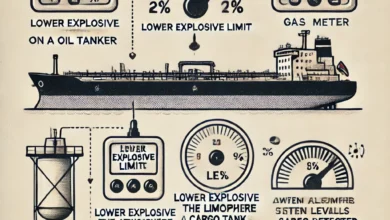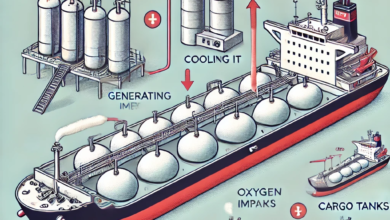Comprehensive Guide to the Lubrication Path of an Air Compressor in Marine Engineering
Introduction to Air Compressor Lubrication
Air compressors are vital equipment in marine engineering, providing compressed air for various applications such as starting engines, operating pneumatic tools, and controlling valves. To ensure smooth operation and longevity, these compressors rely heavily on a well-designed lubrication system. The lubrication path in an air compressor involves circulating oil through critical components to reduce friction, manage heat, and maintain efficiency. This guide will provide an in-depth overview of the lubrication path, its significance, and best practices for maintenance.
Why Lubrication is Critical in Marine Air Compressors
Lubrication plays a fundamental role in the performance and reliability of marine air compressors. Compressors are subjected to high-pressure operations, which generate considerable friction and heat. A robust lubrication system mitigates these effects by forming a protective layer between moving parts, minimizing wear, and carrying away excess heat. Without adequate lubrication, the risk of mechanical failures, overheating, and operational inefficiency increases significantly.
Components of the Lubrication Path
Lubricant Storage and Selection
The lubrication process begins with storing the lubricant, typically oil, in a sump or dedicated oil tank. The selection of the lubricant is crucial, as it must withstand the high temperatures and pressures found in marine environments. The oil must also possess properties such as thermal stability, viscosity retention, and resistance to oxidation.
Oil Pump and Pressure Supply Mechanism
The oil pump is a critical component that initiates the flow of lubricant throughout the compressor. It draws oil from the storage tank and pressurizes it, ensuring that it reaches all necessary components at a sufficient pressure. The pump may be mechanically driven by the compressor or use an external power source, depending on the design.
Oil Filtration System
Before the pressurized oil is routed to the main compressor components, it passes through an oil filtration system. Filters remove contaminants such as metal particles, dirt, and moisture, preventing them from entering sensitive areas like bearings and pistons. This filtration step is vital for maintaining the purity of the oil and ensuring long-term performance.
Detailed Lubrication Path Process
Lubrication of Main Bearings and Shaft
Once filtered, the pressurized oil flows to the main bearings and crankshaft. These are the primary moving parts that bear the brunt of mechanical stress. Consistent lubrication reduces friction and wear, ensuring smooth operation and extending the service life of these components.
Piston Lubrication and Cooling
After lubricating the bearings and shaft, the oil is directed towards the pistons and cylinders. The piston rings, which are in constant motion, generate significant friction. Lubricating the piston rings and cylinder walls minimizes wear and prevents metal-to-metal contact. In some compressors, the lubricant also serves a dual purpose of cooling the pistons by absorbing excess heat, particularly during high-pressure compression stages.
Heat Absorption and Temperature Control
As the oil travels through the compressor, it absorbs heat from various mechanical components. This heat transfer helps regulate the temperature within the compressor, preventing overheating. After completing its lubrication cycle, the heated oil is cycled back to a cooler, where it is cooled to a safe operating temperature before returning to the sump or oil tank.
Types of Lubricants Used in Marine Air Compressors
The selection of lubricant depends on the compressor’s operating conditions and the types of gases being compressed. Common types include:
- Mineral Oils: Suitable for standard applications, offering good lubrication properties.
- Synthetic Oils: Provide superior thermal stability, oxidation resistance, and are often used in high-temperature or extreme conditions.
- Semi-Synthetic Oils: Combine the properties of mineral and synthetic oils, offering a balance between cost and performance.
Maintenance of the Lubrication System
Inspection of Lubricant Quality
Regularly inspect the quality of the lubricant for any signs of contamination or degradation. This includes checking for changes in color, viscosity, and the presence of foreign particles.
Cleaning and Replacing Oil Filters
Oil filters should be cleaned or replaced according to the manufacturer’s guidelines. Clogged filters can restrict oil flow, leading to insufficient lubrication and potential damage to the compressor.
Ensuring Proper Oil Levels
Maintaining the correct oil levels is essential for effective lubrication. Low oil levels can result in inadequate coverage, while overfilling can cause excessive pressure and leakage.
Common Issues in Air Compressor Lubrication
Contamination and Degradation of Oil
Lubricant contamination can occur due to external factors such as water ingress or internal issues like metal wear. Degraded oil loses its lubricating properties and can lead to increased friction and wear.
Overheating and Insufficient Cooling
If the oil cannot effectively absorb and dissipate heat, the compressor may overheat. This can cause thermal degradation of the oil, leading to increased wear and potential component failure.
Oil Leakage and Pressure Loss
Leakages or drops in oil pressure indicate potential issues in the lubrication system, such as damaged seals or malfunctioning pumps. These problems should be addressed immediately to prevent mechanical damage.
Impact of Inadequate Lubrication on Compressor Performance
Inadequate lubrication can lead to several issues, including increased friction, overheating, and premature wear of components. This not only reduces the efficiency of the compressor but can also result in costly repairs and downtime.
Lubrication Path Design Considerations for Marine Applications
In marine environments, the lubrication path must be designed to withstand harsh conditions such as high humidity, corrosive saltwater, and extreme temperatures. Using corrosion-resistant materials and ensuring proper sealing of the lubrication system are essential design considerations.
Energy Efficiency and Lubrication
Efficient lubrication reduces friction, leading to lower energy consumption. A well-maintained lubrication system can significantly improve the overall energy efficiency of the compressor.
Frequently Asked Questions (FAQs)
How often should the lubrication system be checked?
The lubrication system should be checked daily for oil levels and any signs of leakage, while a more thorough inspection should be performed monthly.
What are the signs of inadequate lubrication in air compressors?
Signs include increased noise levels, overheating, erratic pressure readings, and visible wear on components.
Can synthetic oils be used in marine air compressors?
Yes, synthetic oils are often recommended for their superior performance under extreme conditions, but compatibility with the compressor design should be confirmed.


